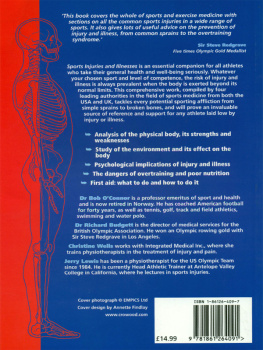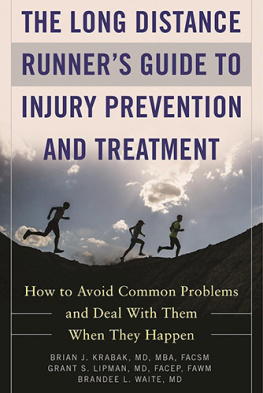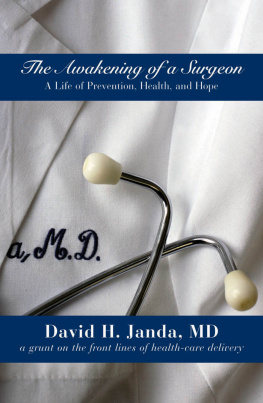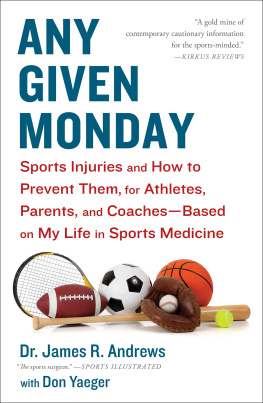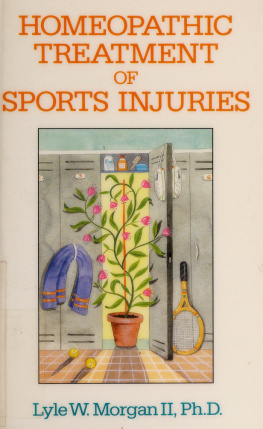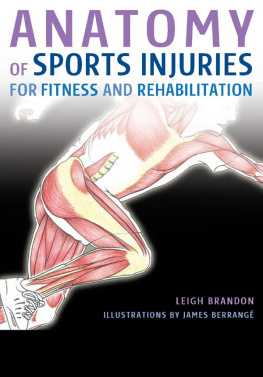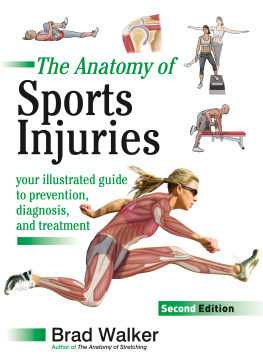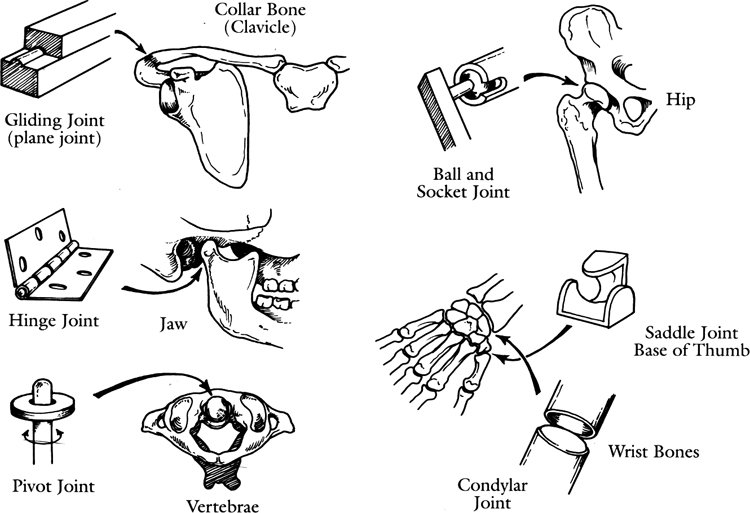SPORTS INJURIES AND ILLNESSES
Their Prevention and Treatment
Bob O'Connor, Ed.D.
Richard Budgett, M.B.B.S., M.A., Dip Sport Med.
Christine Wells, M.S., N.M.A.
Jerry Lewis, M.S., C.A.T.
The Crowood Press
First published in 1998 by The Crowood Press Ltd, Ramsbury, Marlborough, Wiltshire, SN8 2HR
www.crowood.com
This e-book edition first published in 2011
Bob OConnor 1998, 2003
All rights reserved. This e-book is copyright material and must not be copied, reproduced, transferred, distributed, leased, licensed or publicly performed or used in any way except as specifically permitted in writing by the publishers, as allowed under the terms and conditions under which it was purchased or as strictly permitted by applicable copyright law. Any unauthorised distribution or use of this text may be a direct infringement of the authors and publishers rights, and those responsible may be liable in law accordingly.
ISBN 978 1 84797 365 8
Foreword
This book is written for anyone exercising regularly or planning to start an exercise programme. The emphasis is on how to exercise effectively to improve your physical and mental health, as well as how to optimize your performance.
It covers the whole of sports and exercise medicine with sections on all the common sports injuries in a wide range of sports. Early recognition, effective first aid, and the best treatment and rehabilitation are all discussed. Immediate treatment of a sports injury can make all the difference to the speed and effectiveness of recovery. Once you've read this book you will know what to do immediately and when to seek help.
It also gives lots of useful advice on the prevention of injury and illness, from common sprains to the overtraining syndrome. This is done through diet, cross training and conditioning. I hope you will enjoy and benefit from exercise while minimizing the risk of injury and illness, and that this book will help you do that.
Sir Steve Redgrave
Five times Olympic Gold Medallist
Introduction
Physical fitness is an essential part of a healthy life. Adequate exercise not only makes us feel good but makes us look better, while controlling our weight and minimizing our risk of many diseases. The risk of having a heart attack, contracting some cancers, and diabetes, and even suffering from the common cold can be greatly reduced.
Although exercise is undoubtedly good for us, there can be the occasional downside to any physical activity. A sprained ankle, a bruise, blisters, or even a broken bone all are a real possibility. Additionally, it is now known that exercise can even create some negative by-products in the body that must be neutralized if we are to live longer and better.
Just as there are physical benefits and physical problems, there are mental benefits and there can be mental problems. Effective exercise lowers our depression levels and makes us feel more positive about living. It also reduces the stresses that come from other areas of our life. However, too much exercise, a condition called over-training, can increase some harmful hormones and make us feel depressed. Fortunately, most active people never reach that state of overtraining and staleness.
This book has two main focuses. The first is the care and treatment of common athletic injuries. The second is the prevention of injuries and other problems through proper nutrition, strength training, and the awareness of some problems that may occur with those who exercise and train at a very high level.
Exercise and sport can lead to better health. There are two main types of exercise aerobic and strength. Aerobic exercise makes your heart beat fast for at least 20 to 30 minutes. It has the following benefits:
1. increasing the red blood cells that carry oxygen to the tissues. With more red cells, the heart does not have to work as hard to bring sufficient oxygen to the muscles and other tissues, having more rest time between beats;
2. increasing the capacity of the heart so that fewer beats per minute are required for the heart to do its necessary work;
3. increasing many of the white cells and other immunity factors which can reduce the rate of infection and the development of some cancers;
4. reducing the risk of, or the effects of, diabetes;
5. keeping the body physiologically younger;
6. reducing the chance of being overweight;
7. reducing harmful blood fats, which can increase the likelihood of heart disease.
Strength exercise has the following benefits:
1. firms the muscles;
2. strengthens the bones.
Injuries are a fact of life. The English Sports Council recently found that there were 19.3 million sports injuries in a year in England and Wales. Of these injuries, 8.6 million were the result of involvement in soccer.
Finding the right practitioner physician or medical person is sometimes a challenge. You should be aware that not every trained therapist is qualified to work effectively with all sports injuries.
In this book we have attempted to bring you the latest in the medical sciences relating to the prevention and treatment of the injuries and other problems which often accompany athletic training and competition. Most people are aware of both the joys and the physical benefits that accrue from sport participation. Many are also aware that there are times when all doesn't go as well as it should. Our aim is to alert you to how you can prevent problems, but also to enable you both to recognize and to treat a problem if it does occur.
We hope that you enjoy reading the book as much as we have enjoyed writing it.
CHAPTER 1
Understanding and Treating Your Injuries
THE STRUCTURE OF THE BODY
In order to understand athletic injuries, it is essential to have some knowledge of the make-up of body structures and how they help you perform and function properly.
The major building block of the body is the white blood cells, which fight infection. Towards the ends of the bones, there are areas that allow growth in children and adolescents. These are called growth plates. Many injuries to bones occur at the growth plates, since the growth plates are very soft and have immature cells. When tendons (which attach the muscles to the bones) or ligaments (which connect one bone to another) are attached to the growth plates, the growth plates can be pulled out of the bone.

. Front view.
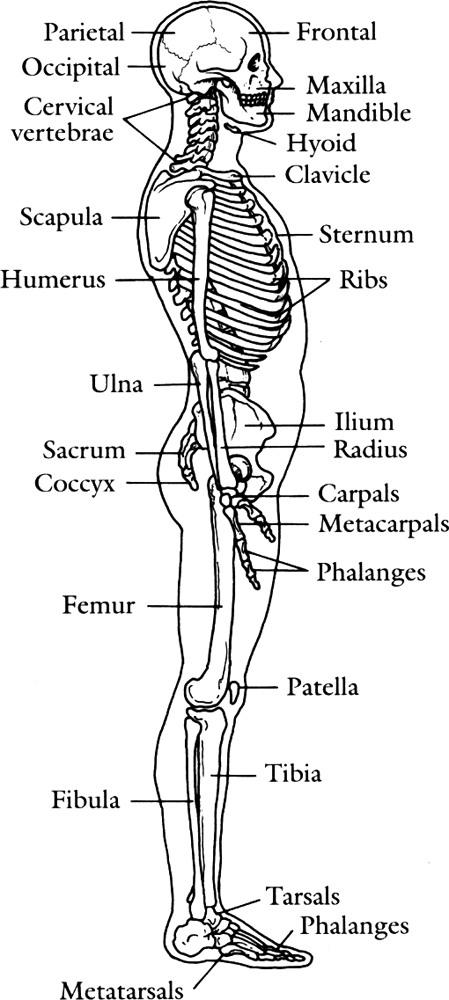
Fig 2. Side view.

. Rear view.
A joint is where two bone ends come together. A joint is significant in that it allows two bones to move or articulate in a particular way, allowing the athlete to perform. The joint is surrounded by a membrane called the joint capsule. The joint capsule helps to hold fluid in the joint area.
At the ends of the bones is a material called cartilage. This material is softer than the bone and is very smooth. It allows the bones to slide past each other, or the tops of the bones that are touching each other to move with little friction. This is aided by the lubricating fluid that is contained in the joint capsule.

